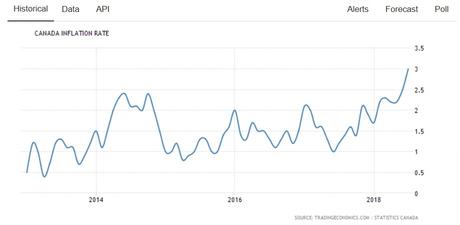This week’s Canadian Inflation Figures spurred the Canadian dollar this week with the Loonie enjoying gains against a multitude of currencies. The figure which smashed its target is now fueling speculation that the Bank of Canada could raise interest rate again. The gains come despite speculation that the US and Mexico could be squeezing Canada out of renewed NAFTA negotiations.
Canadian inflation figures up
The latest monthly Canadian Consumer Price index highlighted a significant increase in this month with the figure increasing 0.5% against a forecast of 0.1%. The inflation rate rise highlights the highest level of inflation since 2011. Annually Canadian inflation now tops 3% up from 2.5% last month.

The increased inflations levels have been attributed to continual fuel cost increases which have increased by roughly 14%. Petrol notably has increased by 25% over the last year. Fuel costs have also been accredited to a rise in air-fuel, in turn, air travel prices have also increased with rises of 28% being seen in Canadian air travel. The cost of eating out has also increased with a 4.4% rise being reported by statistics agencies.
Provinces which saw the largest rises included Alberta which saw an annual inflation rise of 3.5%. British Columbia and Manitoba whose inflation levels increase by 3.3% and Ontario and Saskatchewan whose areas increased by 3.1%.
Likelihood of another Canadian interest rate rise
The improved inflationary pressures have fueled the possibility of further interest rate rises from the Bank of Canada. The most likely time for another interest rate rise by the Bank of Canada remains October, although a pleasant surprise in Canada’s 2nd Quarter GDP figures could tip the scales in Septembers favour. Investors will keep a close eye on the release which is due in at the end of this month. With this being said the Bank of Canada will almost certainly look for a trend rather than raising rates on exceptional month, therefore, showing the inflation data is conclusive and continual.
Debt to income levels in Canada remains high which will almost certainly remain a consideration for the bank. Twelve percent of all Canadian households have a debt to income ratio of 350%. This is particularly prominent in the middle-income bracket especially in younger workers. Consequently, any rate rise will not be made on a whim but more rather than a considered process.
Is Canada being forgotten by the US and Mexico?
Once again the news is back in circulation about NAFTA with Canada being side lined from current negotiation between Washington and Mexico. The US and Canada’s relationship had become more uncomfortable following provocation from President Trump and the reactions from Prime Minster Trudeau.
This Week during a televised event Trump confirmed that the US wasn’t debating NAFTA with Canada currently. Whilst it is far irregular that countries discuss an agreement on a one-to one basis. In particular due to the differences on auto parts and assembly talks, which as of yet haven’t seen much common ground between the US and Mexico.
Despite this, commentators are speculating that Canada has been strategically eased out the NAFTA talks and could therefore have to accept the deal that is formulated between the US and Mexico. Trump however seems undeterred by the pace of the talks, insisting the US is in no rush to approve a deal – unless it is the right one.
Canadian exchange rate performance
The latest Canadian CPI data helped the Canadian Dollar on its way to a 0.56% gain upon the data release. The USD-CAD slipping from 1.3144 to 1.3075. The losses continued before the pair closed at 1.3062 on Friday night.

Whilst investors will await the GDP figures at the end of the month for more confidence in the pair they will have been encouraged by the CPI and Jobs figures from July. Although there is speculation that they could be eased out of talks many institutions believe a deal will be made. If however, the US withdraws from the NAFTA agreement analysts believe the Canadian Dollar could decline by up to 20%. Hence the agreement remains critical to the Canadian Economy and will be as key as inflation, employment or GDP numbers.
Featured image: © Tomasz Rzymkiewicz – stock.adobe.com

